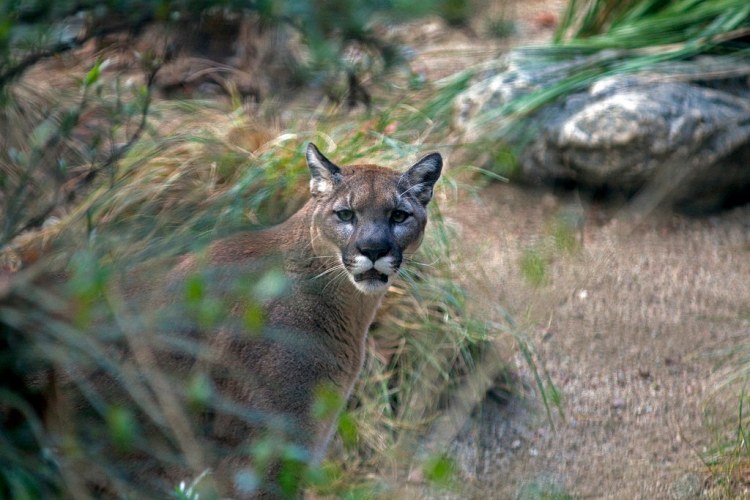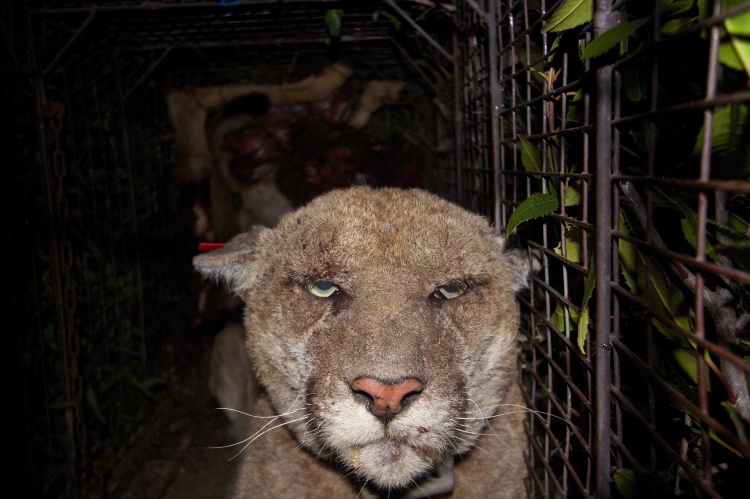
It has been a long time since I have published any research-based posts. Now that I am living in mountain lion (Puma concolor) territory, I have decided to devote more attention to them. So here is a brief introduction to this most adaptable of cats.
Common Names
This is a cat of many names. It is called Puma concolor in the scientific community; mountain lion in the Western United States; cougar in the Eastern U.S.; panther in Florida; and puma throughout much of Latin America. For the remainder of this post I will use the term “puma.”
Range
The reason pumas have so many names is their expansive geographic range. Found from Canada to Southern Chile, they have the widest range of any land-dwelling mammal in the Western Hemisphere (Nielsen, Thompson, Kelly, & Lopez-Gonzalez, 2015). Despite this, substantial portions of the puma’s historic range have been lost. They have been extirpated (regionally extinct) in the Eastern and Midwestern U.S.: although an endangered population of 100-120 individuals persists in Southern Florida (Hunter, 2015).
In addition, there is evidence that pumas have begun to recolonize the Midwest. Breeding populations now exist in South Dakota, North Dakota, and Nebraska (LaRue et al., 2012). Furthermore, in January 2017 a female puma was confirmed in Missouri. This is not definitive proof of a breeding population, but it increases the likelihood of one (Hemmelgarn, 2017).
In South America, pumas have been eliminated from large sections of Argentina and Chile (Hunter, 2015).

Subspecies
There are six genetically distinct subspecies of Puma concolor. They are:
- P. c. cougar in North America
- P. c. costaricenses in Central America
- P. c. capricornensis in eastern South America
- P. c. concolor in northern South America
- P. c. cabrerae in central South America
- P. c. puma in southern South America (Hunter et al, 2015; Nielsen et al., 2015).
Size
Male pumas weigh between 56.2 – 64.4 kgs (124 – 142 lbs), whereas females have been measured between 27.2 – 36.3 kgs (60 – 80 lbs) (Macdonald, Loveridge, & Nowell, 2010, p. 44). Pumas are largest at the Northern and Southern ends of their range, and smallest near the equator (Hunter, 2015).
Adaptability
The puma’s most remarkable feature is its adaptability. From deserts to forests to the outskirts of Los Angeles – they are found in a wide variety of habitats. Pumas have even been recorded at elevations up to 5,800 metres (19,000 ft) (Nielsen et al., 2015).
The puma’s adaptability is also manifest in its diet. They will eat anything. Elk, deer, rabbits, sloths, armadillos, insects, and more: these cats can make due with a diverse range of prey (Hunter, 2015; Panthera, 2017c). But their versatility does not make pumas invulnerable.

Conservation Status
Globally, Puma concolor is listed as Least Concern on the IUCN Red List. But regionally its status varies. It is classified as Near Threatened in Peru, Colombia, Argentina, and Brazil. However, in Brazil all pumas found outside of Amazonia are considered to be Vulnerable (Nielsen et al., 2015).
Threats
Pumas are faced with similar threats as other large cats. Habitat loss and fragmentation, direct killings in order to protect livestock, and overhunting of their natural prey are all contributing to their declining population (Panthera, 2017c; Nielsen et al., 2015). Pumas are also subject to sport hunting throughout much of their range, which in some areas appears unsustainable (Johnson, 2015). Lastly, in Southern Argentina a bounty system still exists in which hunters are paid to kill pumas. Obviously this does not increase the cats’ survival prospects (Hunter, 2015).
A major threat to pumas in my area, Northern California, stems from trespass marijuana grows. These illegal operations put tons of poison into the woods, which kills everything from rodents to pumas. More information about this problem is located here.

Conclusion
The puma is an extremely adaptable cat. It can survive in many different habitats, has a varied diet, and occupies an extensive range. But their extinction in the Eastern half of North America shows that pumas are not invincible. It is still necessary to study and conserve this remarkable species, to make sure they can cope with the changes we are introducing to their landscapes.
Further Reading:
Hunter, L. (2015). Wild cats of the world. New York, NY: Bloomsbury Publishing Plc.
Nielsen, C., Thompson, D., Kelly, M. & Lopez-Gonzalez, C.A. (2015). Puma concolor. The IUCN Red List of Threatened Species 2015: e.T18868A97216466. Retrieved from http://www.iucnredlist.org/details/full/18868/0.
Panthera. (2017). Puma. Retrieved from https://www.panthera.org/cat/puma.
What amazing eyes… They are so beautiful dear Josh, so beautiful. Thank you, it is nice to hear you and what/where are you. Good Luck, Love, nia
LikeLiked by 1 person
They are incredibly beautiful cats, Nia. It’s nice to write about my local wildlife for a change!
LikeLiked by 2 people
Very informative, Josh. Love these beautiful cats, too.
LikeLiked by 1 person
Thanks Debbie; they are quite remarkable.
LikeLiked by 1 person
I had no idea about illegal marijuna crops and poisoning. Another reason to make legal?
LikeLiked by 1 person
In general legalization is probably the right move, but I don’t think it will help for these specific operations. The reason why I called them illegal is that they’re what’s called trespass grows: they occur without the approval of the property owner. So these operations will be subject to the same regulations as other marijuana grows, because no one knows where they are. The best way to deal with them is to find them and shut them down, in order to reduce the competition they pose to ethical growers. Search for ‘trespass marijuana grows’ in this blog’s search bar for more information.
LikeLiked by 1 person
Thank you :)
LikeLiked by 1 person
No problem!
LikeLiked by 1 person
They look magnificent! And this is a very insightful post, Josh. Hope you’re doing great wherever you are. Take care always. :)
LikeLiked by 1 person
Thanks Mitch :) I wish you nothing but the best.
LikeLiked by 1 person
This is an excellent blog…thanks for the info!
LikeLiked by 1 person
I’m glad you liked it!
LikeLike
Reblogged this on Art By Miriam and commented:
This is an excellent blog about the puma…
LikeLiked by 1 person
Thanks Miriam!
LikeLike
Hola Josh! Muy buena información :)
Sigo esperando la noticia que me debes eh! jajaja
Un besoo :)
LikeLiked by 1 person
Pd: Como vas con todo?
LikeLiked by 1 person
Todo es bueno, pero estoy muy ocupado. Como estás?
LikeLike
Genial! Lo importante es que lo disfrutes :) yo bien! Esperando con ansias el frío :D
LikeLiked by 1 person
Hola Ani! Me alegro de que te guste! No te preocupes, voy a decirte todo! Pero primero necesito saber más detalles antes de hacer un anuncio.
LikeLiked by 1 person
Jajaja sii tranquilo, me lo imaginé :) era una broma! No me hagas caso, yo porque cuando me lo propongo suelo ser muy ansiosa :P
LikeLiked by 1 person
Gracias Ani!
LikeLiked by 1 person
That poor cougar looks like he’s in so much pain :c I’ve learned about the downsides of using pesticides before but I never thought they would affect cougars. Thanks for the information!
LikeLiked by 1 person
Anticoagulants, neurotoxins, and all sorts of rodenticides are a major concern for cougars. Since they’re at the top of the food chain in California, they end up accumulating huge amounts of the toxins in their bodies. If we’re talking about anticoagulants, they can literally dissolve the cats’ internal organs.
LikeLiked by 1 person